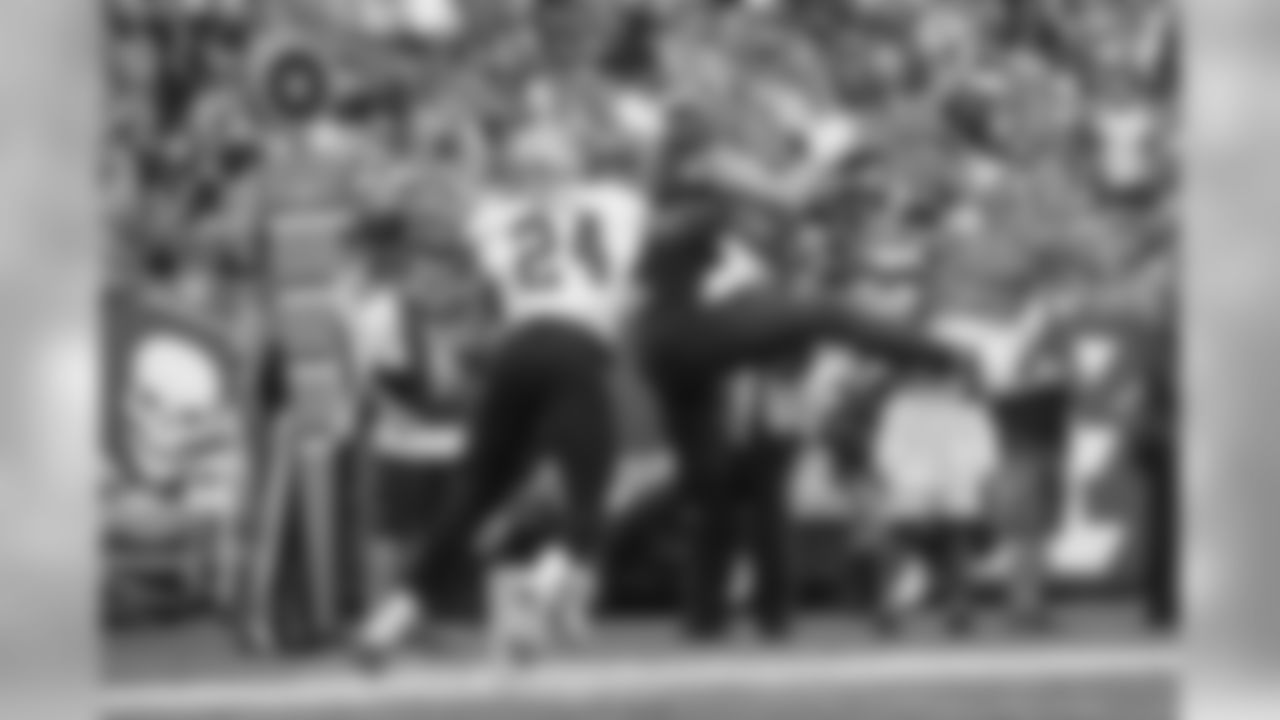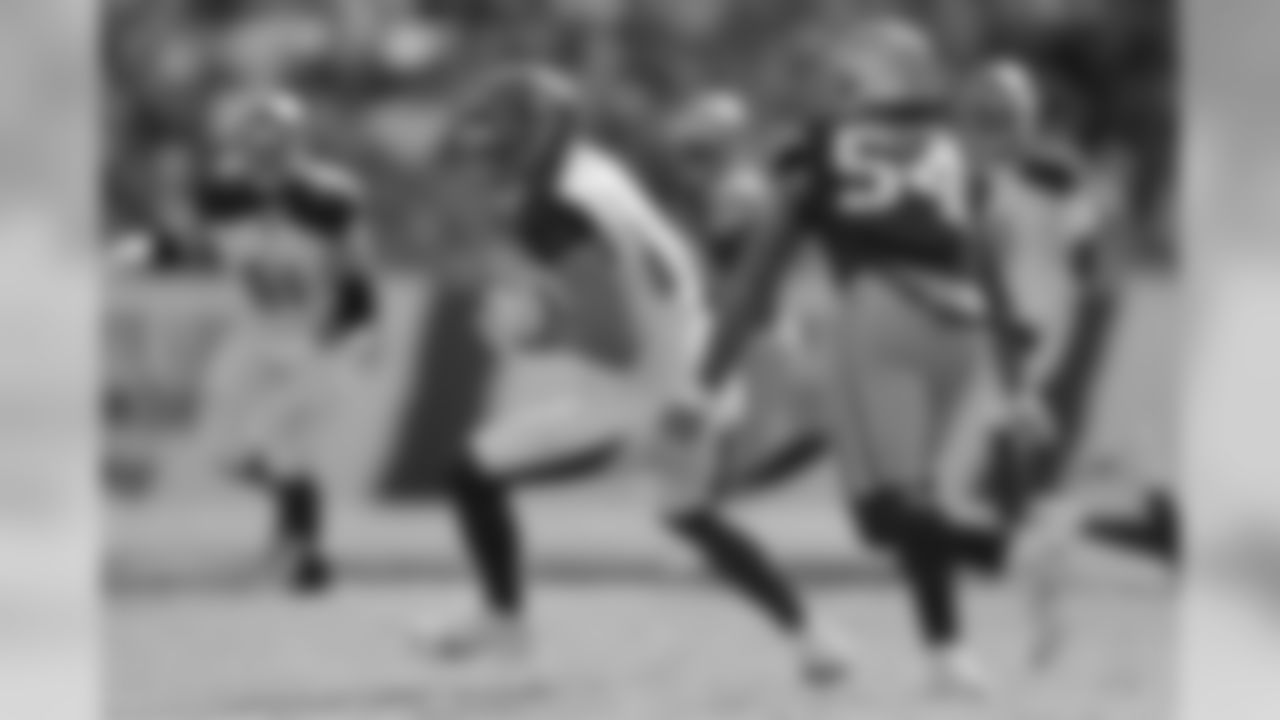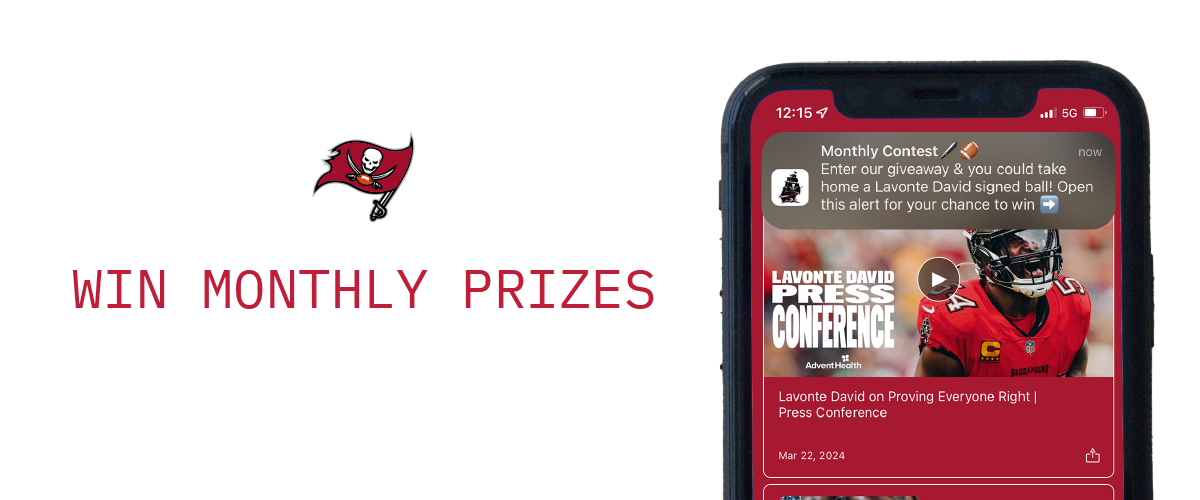View the top photos of TE Cameron Brate from the 2018 season






























In 2017, the Tampa Bay Buccaneers boasted one of the most productive tight end groups in the NFL. Led by Cam Brate and rookie first-rounder O.J. Howard, Tampa Bay tight ends combined to catch 84 passes for 1,124 yards and 13 touchdowns. Only one team – the Zach Ertz-led Philadelphia Eagles – had more touchdowns from their tight ends, with 14 (Seattle also had 13). Only the Eagles (1,202), New England Patriots (1,265) and Kansas City Chiefs (1,358) got more yards from the position than the Buccaneers.
The Buccaneers' 2018 tight end corps, still headlined by Brate and Howard though perhaps not in that same order, saw its production dip in all three categories, though not drastically so. That group combined for 73 receptions, 911 yards and 11 touchdowns. Despite that drop, the team has reason to feel even more optimistic about its tight ends at this point in 2019 than it did a year ago.
The reason is simple: Injuries. Granted better health – which is never a certainty in the NFL but is a decent bet in this case – Tampa Bay should head into next season with the tight end firepower to once again have one of the most dynamic tight end groups in the NFL.
Howard has ended each of his first two NFL campaigns on injured reserve, but neither mishap was the indication of an injury-prone player. Howard's two season-ending injuries have both been to an ankle when he was dragged down awkwardly from behind at the end of a big play. The one in 2018 was more painful – figuratively, though possibly literally as well; only Howard could say – because it hit the pause button on what appeared to be a full-on breakout season for the former Alabama star.
Howard had 565 yards and five touchdowns through 10 games before he went down. He had topped 50 yards in seven of those 10 games, including five of the last six, so he certainly wasn't slowing down. That pace over 16 games would have taken him to 904 yards and eight touchdowns, if maintained, and that would have put him fourth and tied for third, respectively, in the NFL in 2018. Furthermore, his 16.6 yards per catch led all qualifying tight ends last year.
Brate, meanwhile, played in all 16 games but saw his totals fall from 48 receptions for 591 yards in 2017 to 30 and 289 in 2018. He still scored at least six touchdowns for the third straight year, but even Howard's move to injured reserve didn't produce a dramatic spike in Brate's production down the stretch. What seemed obvious – that Brate was playing through a hip injury that was limiting his production from the very start of the season – was essentially confirmed by the coaching staff near the end of the season.
Howard's injury did not require surgery, and that was good news as it shouldn't affect his 2019 timetable. Brate did get surgery, and that's also good because he'll have a very good chance to be back in 2017 form this year. We will still have to learn how new Head Coach Bruce Arians and Offensive Coordinator Byron Leftwich are going to deploy the tight end weapons they've inherited, but it's hard to imagine them not making use of their dangerous tight ends.
Brate got a new contract last spring and Howard is moving into the third year of his rookie contract. In fact, with the retirement of Alan Cross, none of the tight ends on the Bucs' roster require any contract work before free agency begins in 2019. However, every player on the roster has questions to answer in 2019, and that's why we're going to revive our "Burning Questions" series as we approach the beginning of the new league year in March. In the weeks ahead, we're going to pinpoint one burning questions for each player on the roster, going position by position. The tight ends get the first round of scrutiny.
As will be the case at every position, we are only including players who are currently under contract for 2018, or will likely have tender offers as restricted and exclusive rights free agents. For the pending unrestricted free agents, obviously, the burning question that must be answered first is, 'Will they be back?'
One Burning Question for Each Buccaneer: Tight Ends
Players under contract for 2019: 5
Potential unrestricted free agents: None.
Potential restricted free agents: None.
Potential Exclusive Rights Free Agents: None.
**
Antony Auclair: Will he retain his role as the Buccaneers' primary blocking tight end?
Auclair was a priority rookie free agent for the Buccaneers in 2017. In fact, the team went into the draft that year with the Canadian prospect as a possible target in the seventh round but decided against that after surprisingly landing Howard with the 19th overall pick. Making a very big transition from college football north of the border to the NFL, Auclair made the opening-day roster but didn't see much playing time for the first half of the season.
However, he began to see the field in mid-November and gradually took the job of the third, blocking tight end away from veteran Luke Stocker, leading to Stocker's release. That made Auclair's position relatively secure heading into last season and, indeed, he made the team again and played regularly in two-TE sets. His role got even bigger when Howard landed on injured reserve, though he still wasn't frequently targeted in the passing game. He finished the season with seven catches for 48 yards.
Auclair does have an intriguing size-speed combination; he was compared in that regard to Howard to some extent, though obviously the former Alabama star is a much more polished offensive player. Still, the previous coaching staff clearly viewed blocking to be Auclair's main strength at this point in his career; if Arians' crew feels the same way and has use for that position, Auclair may essentially reprise the same role in 2019 as he continues to develop his overall game.
**
Cameron Brate: Will he continue to pile up touchdowns as a top red-zone threat?
As noted above, Brate still found the end zone six times in 2018 despite being limited somewhat by his hip injury. While his reception total dropped by nearly 40% from 2017 to last year, Brate still scored just as many touchdowns. He also had eight scoring grabs in his 2016 breakout season, tying for the NFL lead that year. Of all the tight ends in the NFL, only the Chiefs' Travis Kelce, with 22, has more touchdown catches than Brate since the start of 2019. Brate's 20 in that span have also been matched by Ertz. Kelce and Ertz are without a doubt two of the very best tight ends in the league at this moment.
Brate is the only tight end in the NFL who has caught at least six touchdown passes in each of the last three years. Can he do it again in 2019? The good news is that Arians has made it clear that Jameis Winston will remain the team's starting quarterback, and that he thinks Winston can hit new career heights. Brate and Winston clearly have a connection, especially in the red zone; Brate's production in the past two seasons has been far better when Winston was under center than when Ryan Fitzpatrick has been filling in.
It's less obvious how the arrival of Arians and his offensive system will affect Brate's usage and prominence in the offense. The Cardinals never had a tight end reach 40 catches or 500 yards in a season during Arians' four years at the helm in Arizona, but that might have been a matter of available personnel. When the Cardinals had the NFL's number-two passing attack in 2015, for instance, the offense was loaded with productive wideouts, led by Larry Fitzgerald, and also had a pass-catching back in David Johnson. The tight ends were Darren Fells (21-311-1) and Jermaine Gresham (18-223-1).
**
Donnie Ernsberger and Tanner Hudson: Can either or both turn a late season call-up into a more permanent spot on the active roster?
Occasionally in this series we'll group a couple of young players together when their careers seem to be in a nearly identical place. That's the case here for Ernsberger and Hudson, both of whom were promoted from the practice squad very late in the year but neither of whom saw significant playing time. Hudson, in fact, was inactive for his three games on the 53-man roster while Ernsberger appeared in two contests and played six offensive snaps.
That said, merely making the roster at any point during their shared rookie campaign counts as success for Ernsberger and Hudson, both of whom arrived as undrafted free agents having already overcome other obstacles. Ernsberger started out as a walk-on at Western Michigan but gradually developed into one of the team's leaders and top performers. Hudson started out as a quarterback at Memphis but later changed both schools, transferring to Southern Arkansas, and positions.
Ernsberger was seen as an H-back type in the Alan Cross mold, and that takes on more significance with Cross retiring. Of course, it remains to be seen if that type of position will have a role in Arians' offense. At 6-5 and 239 pounds, Hudson profiles as a more traditional tight end and he put up big receiver numbers at Southern Arkansas.
Dirk Koetter's Buccaneers listed two starting tight end positions and generally kept at least four on the active roster, sometimes more. The size of the regular-season opportunity for these two young players could depend in part on how big of a tight end group Arians and company want to keep.
**
O.J. Howard: Can he become the Bucs' first Pro Bowl tight end in more than three decades?
Howard's injury in the 10th game last season was a disappointing turn of events for a number of reasons, not the least of which was his growing importance to the Bucs' offense. It also represented the lost opportunity of six games in which the second-year pass-catcher could have continued to pile up numbers in his personal stat line. That 904-yard projection noted above, if reached, would have given Howard the franchise's single-season record for a tight end.
It also might have ended a long Pro Bowl drought for the Buccaneers. Ring of Honor member Jimmie Giles, to this point the best tight end in team history, went to the last of his four NFL all-star games at the end of the 1985 season; the Bucs have not sent another tight end to the Pro Bowl since. Would Howard have ended that shutout had he stayed healthy for 16 games?
The numbers suggest that he would have been deserving of the Pro Bowl, at least. As mentioned above, 904 yards would have been fourth in the NFL among tight ends, third among those who played in the NFC, which would have been Howard's direct competition. If you don't like projections, we can also note that Howard was fifth in the NFL in receiving yards among tight ends when his season came to an end, and third in the NFC. In both cases, the two NFC tight ends ahead of Howard were San Francisco's George Kittle and Philadelphia's Zach Ertz. Both were obviously deserving of the two spots that were allocated to their position, but Ertz pulled out of the game and was replaced by Atlanta's Austin Hooper. Hooper finished the year with 660 receiving yards and four touchdowns.
Of course, being deserving and actually being selected are two different things. The Bucs' down season and Howard's lack of previous Pro Bowl pedigree would have worked against him. However, he does have something of a higher profile given his history at Alabama and his high draft-pick status. At the very least, Howard likely registered as a rising star with many NFL fans. If he can continue to produce at the same level in 2019 and get a little more lucky in the injury department, Howard could become the Bucs' first Pro Bowl tight end in 34 years, and the first one ever drafted by the team.
























